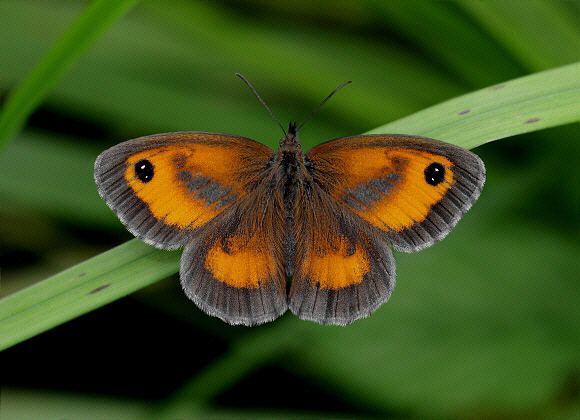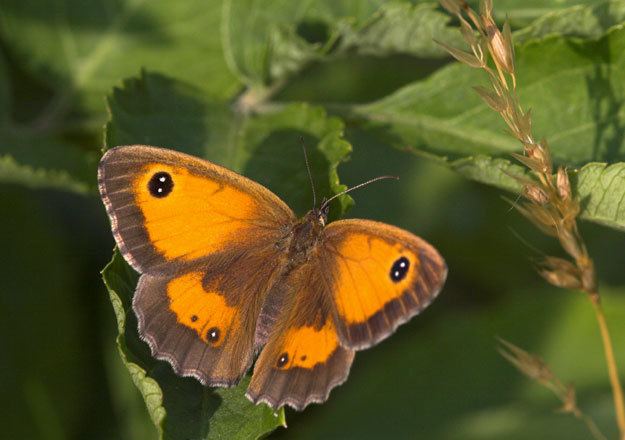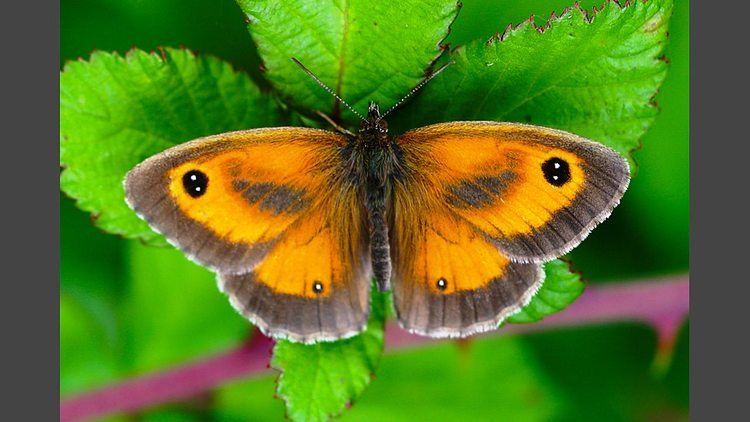Higher classification Pyronia | Scientific name Pyronia tithonus Rank Species | |
 | ||
Similar Meadow brown, Pyronia, Butterfly, Speckled wood, Butterflies and moths | ||
The gatekeeper (Pyronia tithonus), sometimes called the hedge brown, is most commonly found in South and East Britain, and confined to coastal areas of south and southeast Ireland. It is also found in the Channel Islands, but not in Scotland nor the Isle of Man. Given its preference for warmer weather, it can be assumed that the restriction of range expansion is due to climate. Colonies will vary in size depending on the available habitat, and can range from a few dozen to several thousand butterflies.
Contents
- Similar species and subspecies
- Physical appearance
- Sexual dimorphism
- Distribution
- Recent expansion and genetic diversity
- Food
- Larval foodplants
- Nectar sources
- Activity
- Weather influences
- Sexual reproduction
- References

Similar species and subspecies
It is a member of the subfamily Satyrinae in the family Nymphalidae. A similar species is the meadow brown; the two species can be difficult to distinguish with closed wings since the underwing markings are very similar. However, the gatekeeper tends to rest with its wings open, whereas the meadow brown usually rests with its wings closed. The gatekeeper is also smaller and more orange than the meadow brown and has double pupils on its eyespots.

Two similar species of Pyronia are found in southern Europe, the southern gatekeeper (P. cecilia) and the Spanish gatekeeper (P. bathsheba).

Pyronia tithonus has two known subspecies. Pyronia tithonus ssp. brittaniae, defined by Verity in 1915, is the subspecies represented in the British Isles. Pyronia tithonus ssp. tithonus, defined by Linnaeus in 1771, is not found in the British Isles. Instead, this subspecies is seen in Central and Southern Europe except Southern Italy and in the Mediterranean Islands except for South Corsica and Sardinia.
Physical appearance
The gatekeeper is orange with two large brown spots on its wings and a brown pattern on the edge of its wings. The eyespots on the forewing most likely deflect bird attacks away from the butterfly’s body, therefore the gatekeeper is often seen resting with its wings open. There are a large number of aberrant forms, such as excessa, where specimens have two to four extra spots on the forewing upperside. The number of spots on the hindwing underside also varies.
Sexual dimorphism
The male has a dark patch on the upper side of the forewing that contains scent-producing scales known as the androconia. This is most likely for courtship purposes. Androconia have evolved through sexual selection for the purpose of releasing pheromones for attracting mates. Little is known about how androconium actually function during courtship, and the chemical composition of the pheromones also remains unknown.
Females typically have more spots than males. Males have more costally placed eyespots, compared to the females whose eyespots are more spread over the wing margin.
Distribution
As indicated by its alternate name, the gatekeeper butterfly prefers the habitat of meadow margins and hedges; field gates are often in such locations, and thus the gatekeeper can be found much more frequently in such locations than the meadow brown for example.
Recent expansion and genetic diversity
Early in the 20th century, Pyronia tithonus was common in southern Britain, but sparsely populated in the north. In fact, the population contracted before re-expanding beginning in the 1940s. Over the past three decades, the flight range of the gatekeeper has extended northwards in Britain. Furthermore, the length of the flight period has been observed to be significantly shorter close to the edge of the range, suggesting that the extension of flight period and expansion of range are likely to be related. However, the mean flight date and length of flight period are not related. It has also been found that larger individuals cover longer distances, and this recent expansion of the gatekeeper may explain the larger size of recent populations.
As a result of recent expansion, the gatekeeper is found in a wide variety of habitats. Some of the largest colonies can be found in scrubby grassland, woodland rides, country lanes, hedgerows, and other similar conditions within its range. This has led to a greater degree of genetic diversity seen in the gatekeeper compared to other species, such as P. aegeria, which are seen in more limited habitats. However, the contraction of abundance in the early 20th century has limited the potential of this genetic diversity, as bottlenecks and repeated founder events could have occurred during range changes.
Much of the data on changes in Pyronia tithonus population size has been gathered from the UK Butterfly Monitoring Scheme. This scheme has recorded changes of abundance for 71 species between Britain and Ireland since 1976 through visits to more than 1500 separate monitoring sites.
Food
Pyronia tithonus is a characteristic field margin species, which feeds on grasses, food plants as larvae, and nectar. The larvae of Satyrinae all feed on grasses, such as rough meadowgrass Poa trivialis, smooth meadow grass Poa pratensis, sheep's fescue, and are usually green or brown in colour. The pupae are a flimsy chrysalis either hanging upside down or lying in grass. The adults are often found around blackberry plants. The adult butterflies have a short proboscis and the shallow flowers of the blackberry provide an excellent nectar source.
Larval foodplants
The primary larval foodplants are bents (various) (Agrostis spp.), fescues (various) (Festuca spp.) and meadow-grasses (various) (Poa spp.). common couch (Elymus repens) is also used.
Nectar sources
Adults feed primarily on bramble (Rubus fruticosus agg.), carline thistle (Carlina vulgaris), devil's-bit scabious (Succisa pratensis), fleabane (Pulicaria_dysenterica), hemp agrimony(Eupatorium cannabinum), wild privet (Ligustrum vulgare), ragwort (Jacobaea vulgaris), red clover (Trifolium patense), thistles (Cirsium spp. and Carduus spp.), thyme (Thymus praecox) and water mint (Mentha aquatica).
Activity
The gatekeeper butterfly tends to rest on vegetation during overcast or hazy sunshine conditions. During sunny weather, it will fly from flower from flower gathering nectar. The gatekeeper is a relatively active butterfly but not very mobile, as seen when comparing it to a similar species, Maniola jurtina. Mobility in butterflies refers to the amount of distance covered from flying, while activity refers to how often they are in flight. In an experiment assessing wing damage, Pyronia tithonus showed faster wing damage as a result of their increased activity, and these results showed that activity levels do not necessarily correlate with mobility. Their low mobility levels can also explain the observation that they may be very abundant at one site, but lacking at another having a similar habitat only a few kilometers away.
Males fly more and are generally more active by spending most of their time locating mates. Pyronia tithonus is a protandrous species, meaning the males emerge before the females. As a result, females usually only mate once, so they have more time available for resting, nectar feeding, host plant selection and oviposition.
Weather influences
Despite the potential impact of other environmental factors, weather has been found to have a significant influence on fluctuations in population size. Warm, dry summers tend to result in the biggest increase in gatekeeper population size. This weather trend may explain why Pyronia tithonus numbers have been low in northern Britain because of the cooler summers and that range expansion has resulted from a climate change in northern Britain. Weather as a cause for changes in relative abundance has been supported in other ways as well. Changes have also been synchronous between species including Pyronia tithonus, with weather being a potential explanation. Based on these findings on the impact of climate, Pyronia tithonus abundance is expected to become 50% greater by 2080 given a high climate change.
Sexual reproduction
There is one generation of gatekeeper butterflies each year with adults emerging in July, peaking in early August, and only a few adults remaining at the end of the month. There is no known specific courtship ritual; however the male scent spots most likely play a role. Males will set up small territories, and actively seek out a mate. Copulation lasts for approximately an hour during which the butterflies remain stationary with their wings closed. Females will lay between 100 and 200 eggs, usually in the shade or at random by ejecting eggs into the air. Initially larvae are yellow, but soon develop brown patches and continue to darken it develops within the egg. Eggs hatch after about 14 days.
